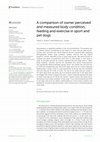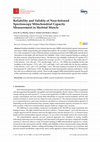Papers by Heidi A. Kluess
The Faseb Journal, Mar 1, 2006

Frontiers in Veterinary Science, Oct 11, 2023
Dog obesity is a significant problem in the US and elsewhere. The purpose was to evaluate factors... more Dog obesity is a significant problem in the US and elsewhere. The purpose was to evaluate factors contributing to pet obesity in sport and pet dog owners. Owners were recruited over social media to answer a questionnaire regarding demographics, health, body condition, feeding, exercise and dog related expenses. Owners identified as pet or sport dog owners. We asked owners to measure the pelvic circumference and hock to stifle length in their dogs in order to calculate percent fat. Owners reported that their dogs were in "ideal" body condition. However, percent fat calculated from owner measurements was significantly different between groups (Sport: 16 ± 10%fat; Pet: 24 ± 10% fat; p < 0.05) and revealed that over 50% of the dogs were over fat. Owners reported feeding dogs a range of 413 to 1,133 Kilocalories (Kcal) per day that correlated well with dog size (R = 0.58; p < 0.05). The size of the treats fed was smaller in the Sport dogs (treat was pinky nail to thumbnail sized) than in Pet dogs (treat was bigger than thumb to larger than palm). Owners reported walking their dogs on leash every day for 15-45 min per session. Overall, owners did a poor job in identifying correct body condition of their dogs. This is concerning because 50% of the dogs were over fat. Better understanding of correct body condition and feeding for the level of physical activity is still a critical issue in controlling obesity in pet dogs.

The FASEB Journal, 2014
Dipeptidyl-Peptidase IV (DPP-IV) is an enzyme present in the blood, acting as a regulator for inc... more Dipeptidyl-Peptidase IV (DPP-IV) is an enzyme present in the blood, acting as a regulator for incretin hormones, such as glucagon-like peptide(GLP-1) and glucose-dependent insulinotropic polypeptide (GIP). As a result of this regulatory action, DPP-IV has become an enzyme of interest in the pathology of Type 2 Diabetes. Currently, values are measured primarily in the plasma. It has been suggested that values can be measured in saliva; however, the relationship between DPP-IV levels in plasma and saliva is not well researched. Plasma and saliva samples were collected from 5 healthy college aged students. Blood was collected using standard venipuncture from prominent antecubital vein. Plasma was separated by centrifugation for 10 minutes at 1,000g and 4°C. Saliva was collected by subjects spitting into a cup, then stored in 0.5mL aliquots at -80°C until analysis. DPP-IV activity was determined using a fluorometric assay which measures the release of 4-methoxy-2-naphthylamine. Enzymati...

Journal of Speech, Language, and Hearing Research, 2020
Purpose This preliminary study examined the influence of menstrual cycle phase and hormone levels... more Purpose This preliminary study examined the influence of menstrual cycle phase and hormone levels on acoustic measurements of vocal function in reproductive and postmenopausal females. Mean fundamental frequency (f0), speaking fundamental frequency (Sf0), and cepstral peak prominence (CPP) were evaluated. It was hypothesized that Sf0 and CPP would be lower during the luteal and ischemic phases of the menstrual cycle. Group differences with lower values in postmenopausal females and greater variability in the reproductive females were also hypothesized. Method A mixed factorial analysis of variance was used to examine differences between reproductive and postmenopausal females and the four phases of the menstrual cycle. Separate analyses of variances were implemented for each of the dependent measures. Twenty-eight female participants (15 reproductive cycling, 13 postmenopausal) completed the study. Participants were recorded reading the Rainbow Passage and sustaining the vowel /a/. ...
Frontiers in Physiology, 2020
Dipeptidyl peptidase IV (DPP-IV) is a unique serine protease that exists in a membrane bound stat... more Dipeptidyl peptidase IV (DPP-IV) is a unique serine protease that exists in a membrane bound state and in a soluble state in most tissues in the body. DPP-IV has multiple targets including cytokines, neuropeptides, and incretin hormones, and plays an important role in health and disease. Recent work suggests that skeletal muscle releases DPP-IV as a myokine and participates in control of muscle blood flow. However, few of the functions of DPP-IV as a myokine have been investigated to date and there is a poor understanding about what causes DPP-IV to be released from muscle.

Journal of Functional Morphology and Kinesiology, 2018
Establish reliability of near-infrared spectroscopy (NIRS) mitochondrial capacity measurement and... more Establish reliability of near-infrared spectroscopy (NIRS) mitochondrial capacity measurement and assess validity using heating and cooling interventions. We recruited 13 participants for four visits. Two visits consisted of a series of blood pressure occlusions proximal to the NIRS probe and electrical stimulation to the thigh, calf and forearm for reliability. Visits 3 and 4 required heating or cooling of the three muscles, using the protocol above. The between day reliability coefficient of variation (CV) in the forearm was 3% and time constant (TC) average was 41.9 ± 9.2 seconds (s). The within day CV in the forearm = 4.5%, the calf = 5.5% and the thigh = 4.6% (n = 13). Within day reliability for the cold condition in the forearm = 5.9%, calf = 4.3% and thigh = 4.4% and within day for the hot condition in the forearm = 6.4%, calf = 5.3% and thigh = 4.6%. The cold condition increased TC in the forearm, but decreased TC with heat (p < 0.05). The thigh decreased mitochondrial ca...
Medicine & Science in Sports & Exercise, 2014
Medicine & Science in Sports & Exercise, 2017










Uploads
Papers by Heidi A. Kluess